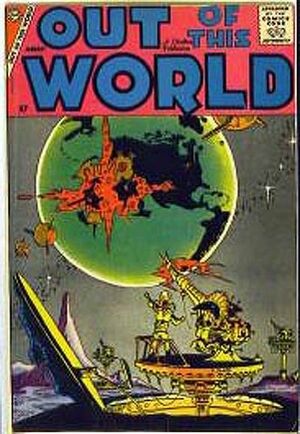Harvey Comics Database Wiki
From Hey Kids Comics
<mainpage-leftcolumn-start />
|
|
|
| Overview · Searching · Editing · F.A.Q. · Help |
HARVEY COMICS ARE HAPPY COMICS[edit | edit source]File:Harvey1.jpg 200px He was the original "Al the kiddies' pal." Publisher Alfred Harvey was born in 1913, and his name is enshrined in the history of American comic books, hundreds and hundreds of titles having issued from the house of Harvey Publications since Pocket Comics No 1 came out in 1940. One of his several subsidiaries, Family Comics, describes both his style and his setup: Alfred Harvey, President; Leon Harvey, Editor and Vice-President; Robert Harvey, Vice-President and business manager. Alfred Harvey was 25 years old when he and his brothers entered the comparatively new world of comic-book publishing in 1939. This 10-cent picture-book business was barely six years old and had only recently, with the creation of 'Superman' and 'Batman', burst into the big time. File:Harvey3.jpg New York in the 1940s with (left to right) Alfred Harvey, Fred Rhoads and George Baker Hoping to crash the market with something different, Harvey produced the first issue of Pocket Comics, a half-size booklet bursting with 100 pages of full-color strips. Despite a shoal of super-heroes, ranging from 'The Red Blazer' to the super-woman 'The Black Cat', Harvey had, by breaking a popular format, made the same mistake as previous pioneers in the business. Tabloid-size comics such as The Funnies (1929) and oblong comics, such as Nickel Comics (half size, half price) in 1938, had been among the many failures. The lesson to be learnt was that the standard half-tabloid comic book, virtually unchanged to this day, was the one the children wanted. It was comfortably thick (68 pages) and rolled up nicely in the back pocket. Abandoning novelty value, Harvey took over a fairly successful title, Speed Comics, and after a tryout in his pocket format, relaunched it with a starring spot for his beloved 'Black Cat'. The comic was a success, and a few years later the black-clad glamour girl was rewarded with her own title. Black Cat Comics began in 1946, and followed the market trends of the times by converting to Black Cat Western in 1949, and in the era of the horror comic, Black Cat Mystery in 1951. Harvey's most successful comic of the Forties was Sad Sack, a series based on the famous wartime strip created by an ex-Disney animator called George Baker. 'The Sack', a wonderful strip told in pantomime (without dialogue) every week in the US Army magazine Yank, featured the nation's most hopeless, useless and witless GI, virtually permanently on 'KP' ('Kitchen Police'), the lowest form of life in the Army. Baker drew the strip from 1942 to demob, then revised his Sack as an equally worthless civilian for syndication as a Sunday strip. He was no world-beater in civie street, however, but Alfred Harvey, who loved the character, saw its potential as a comic book. He published Sad Sack Comics No 1 in September 1949, with the 'hero' back in the Army, and George Baker himself drawing the cartoon cover. The success of the comic brought no fewer than 14 other titles ranging through Sad Sad Sack World (a nod to the hit movie, Mad Mad Mad World), and a variation for feminists, Sadie Sack. After the so-called Horror Comics Scandals of the Fifties, Harvey concentrated on family reading, and took on comic-book versions of the only truly junior-orientated cinema cartoons then being produced. These were the 'Noveltoons' of Famous Studios, who released through Paramount Pictures. The characters included 'Little Audrey', and their most popular of them all, 'Casper the Friendly Ghost.' The first Casper animation had been made in 1945, but an official revival of the character in a series of shorts inspired Harvey to buy the rights in 1952. No fewer than 23 different regular titles ensued, starring Casper and his supernatural pals, the Ghostly Trio, Spooky the Tuff Ghost, and Wendy the Good Little Witch. Inspired, Harvey ended up by purchasing the whole Noveltoon collection from Paramount. Removing the familiar logo, a jack-in-the-box holding the title lettering, he had a new animated logo added, calling them 'Harveytoons', packaging them into half-hours for children's television. As if this was not enough, one of his own original characters, 'Richie Rich', the Richest Boy in the World, was now made into his own animated series. Harvey had made himself the uncrowned king of cartoons in all their forms. Harvey retired in 1977, and finally sold his publishing empire in 1989 to Jeffrey Montgomery. He died in Larchmont, New York on July 3, 1994. Montgomery still calls the company Harvey Comics, continues to publish books that are ideal for youngsters, and package cartoons that now entertain video audiences on cable and satellite. Following Harvey's policy, he has introduced comics starring such old-time but still popular characters as 'Popeye the Sailor' and 'Felix the Cat'. It seems that the hallowed name of Harvey will continue as long as children love comics.
Latest activity[edit | edit source]<activityfeed/>
Quote of the Week[edit | edit source]
Harvey Comics Database News[edit | edit source]
Affiliates[edit | edit source]Atlas Comics Database · Archie Comics Database · CrossGen Database · Dark Horse Database · DC Database · Disney Comics Database · Dynamite Comics Database · Marvel Comics Database · Image Database · Malibu Comics Database · Harvey Comics Database · Pacific Comics Database · Valiant Comics Database · Zenescope Comics Database |
<mainpage-endcolumn /> <mainpage-rightcolumn-start />
<mainpage-endcolumn />
Template:W:Comicfooter


